Viola stoneana House
Common names:
Stone's Violet
Synonyms:
Viola stoneana House, Bull. Torrey Bot. Club 32: 253, pl. 16. 1905. TYPE: USA, Pennsylvania, Chester Co., Kennett Square, Colony No. 6, 4 Jul 1903, W. Stone 5113 (HOLOTYPE: US490405 [barcode 00114618]!; ISOTYPES: F676547!, NY barcode 01911884!; internet images!).
Description:
Acaulescent rosulate perennials from thick rhizome, ≤ 34 cm tall; foliage and peduncles green, lower surface of leaf blades sometimes paler than upper, foliage and peduncles glabrous or petioles and lower surface of leaf blades sparsely hirsute; stipules free, glandular-fimbriate; heterophyllous, leaves ascending to spreading, earliest and latest leaf blades undivided, blades in chasmogamous flower through summer cleistogamous fr deeply biternately divided into 7 or 9 lobes with central and lateral lobes of the terminal primary division rhombic-lanceolate and lateral primary divisions deeply 2–3-cleft, sinuses of terminal and lateral primary divisions reaching nearly to petiole summit, base of divisions usually constricted to a slender elongate "petiolule", largest ≤ 110 × 148 mm, outline ovate to broadly ovate, in summer broadening to reniform, base deeply cordate, margins irregularly or remotely serrate, ciliolate, apex obtuse; chasmogamous peduncle held among the leaves; chasmogamous flower ≤ 22 mm; calyx glabrous, eciliate; lowest sepals lance- to ovate-triangular, acuminate; auricles short and entire, not elongating in fruit; corolla blue to purple, throat white; spur short-globose; lateral petals densely bearded with narrowly linear or slightly clavate hairs, spurred petal glabrous; chasmogamous capsule green; cleistogamous flowers produced after chasmogamous, on ascending to erect peduncles nearly equaling (rarely much shorter than) petioles, capsule 7–14 mm, green drying tan with weak (rarely strong) purple spots or blotches, glabrous; seeds 1.8–2.3 × 1.1–1.6 mm, seeds ivory to tan or light gray-brown, unspotted or with small weak brown spots or rectangular blotches.
Similar species:
This species is most similar to the other widespread heterophyllous violet with pubescent foliage in our region, Viola palmata
. It differs from that species in its nearly glabrous to glabrate foliage, primary divisions of the divided leaf blades typically abruptly contracted into slender "petiolules", glabrous peduncle, eciliate calyx, lance-triangular to ovate-triangular acuminate sepals, finely spotted cleistogamous capsule on a suberect peduncle, and ivory to light gray-brown unspotted or weakly spotted seeds.Ecology:
Moist loamy soils of rich mesic forest slopes and bases of slopes.
Distribution:
Distributed along and near the "fall line" between the upper Atlantic Coastal Plain and the lower Piedmont, se. NY south VA, disjunct in e.-c. NC.
Rarity:
None.
Phenology:
Chasmogamous flower April–July, chasmogamous fruit May–August, cleistogamous fruit May–September.
Affinities:
This species belongs to the Acaulescent Blue Violet lineage, sect. Nosphinium W.Becker, subsect. Boreali-Americanae (W.Becker) Gil-ad, in the Palmata species group.
Hybrids:
Hybridizes with V. communis [or possibly V. "sororia glabrous" or V. "sororia hirsutula-like"] (Brainerd 1912, 1924), V. emarginata (Brainerd 1924), V. hirsutula (Brainerd 1912, 1924), V. palmata var. triloba (Brainerd 1910b, 1912, 1924), and V. sororia sensu stricto (Harvey Ballard pers. comm.). Brainerd reported that these exhibit intermediate or recombinant characteristics of foliage, chasmogamous flowers, cleistogamous capsules and seeds (where these did not abort). He noted no reproduction by chasmogamous flowers, and substantially to dramatically reduced viable seed production in cleistogamous capsules.
Comments:
House stated in his protologue that "The type of Viola Stoneana is Witmer Stone's no. 5113, collected near Kennett Square, Pa., May 7, 1903. No. 5112, a flowering specimen, is identical (National Herbarium numbers, 490405 and 490404.) Material in the National Herbarium shows the range of this species to extend as far south as Virginia." Since the protologue specifies Stone 5113 at US, with an accession number, as the "type", the US sheet is unambiguously the holotype. On the holotype sheet the date given is "July 4/03", and at the bottom is written, in the same hand as the label data, "(printed date is an error)". A VT sheet is ambiguous, with most of the same collection data as the holotype but with "May 25/03" clearly written on the label, discounting it as an isotype.
Brainerd (1921b), Brainerd Baird (1942), Fernald (1950) [who erroneously reported it from Kentucky], and Alexander (1963) accepted the present species as distinct. Russell (1965) misapplied the name to a putative hybrid assemblage in the southern Appalachians. Gleason and Cronquist (1991), McKinney (1992), Ballard (2000), McKinney and Russell (2002), Weakley et al. (2012), and Little and McKinney (2015) included it in a broadly defined V. palmata. Gil-ad (1995, 1997, 1998) examined specimens identified as this by Brainerd and a collection made by himself from northeastern North Carolina. He noted similarities with V. triloba as well as differences in leaf blade shape, color pattern of the capsules, and shorter seed caruncle. Micromorphological characters of the seeds were not unique, appearing to share features with V. affinis, V. sororia, and V. triloba. Correlations of macromorphological and micromorphological features led him to conclude that V. stoneana was likely a hybrid derivative involving V. triloba and V. affinis, V. missouriensis, or V. sororia. Gil-ad stated that V. stoneana should "perhaps be recognized on the basis of micromorphology and distribution alone", but that is should be dismissed due to evidence of hybrid origin. I have examined a substantial number of specimens from the range confirmed by Brainerd and have visited and studied materials from several northeastern populations as well as a North Carolina population I discovered based on a misidentified specimen. This species diverges consistently in a substantial suite of features of foliage, chasmogamous flowers, cleistogamous capsules and seeds from V. palmata and other similar heterophyllous taxa that cannot be constructed as the product of hybridization involving any known taxa. Moreover, correctly identified specimens and confirmed living populations are highly uniform in morphology, fully fertile and reproduce by both chasmogamous and cleistogamous flowers, have a definably discrete range along the "fall line" of the northeastern and east-central Piedmont, and inhabit richer mesic forests and forest slopes than the the dry-mesic forests preferred by V. palmata and other taxa in the Palmata species group. It rarely makes contact with V. palmata or other presumably related species. Under the Unified Species Concept, available evidence supports recognition of the present taxon as a distinctive regionally endemic species. Most collections have been taken in the northeastern states, from southeastern Pennsylvania south to Fairfax, Virginia; however, a collection from Nash County by Gil-ad (1995, 1997) and a collection from Chatham County by me document a range extension southward into east-central North Carolina. Additional fieldwork is urged to seek this interesting species in southern Virginia and elsewhere in North Carolina. Plants with less deeply divided leaf blades and more heavy foliage pubescence are frequent hybrids with V. sororia; some of these have inaccurately been identified or annotated as V. stoneana, adding to unnecessary confusion and misinterpretation of close similarity to V. palmata.
Literature Cited:
Alexander, E. J. 1963. Violaceae. In Gleason, H. A., The new Britton and Brown illustrated flora of the northeastern United States and adjacent Canada. Hafner Publishing Co., Inc., New York, NY. 552-567.
Ballard Jr., H. E. 2000. Violaceae. In Rhoads, A. (ed.). Flora of Pennsylvania. University of Pennsylvania Press, Philadelphia, PA. 700-710.
Brainerd, E. 1910b. The evolution of new forms in Viola through hybridism. American Naturalist 44: 229-236.
Brainerd, E. 1912. Violet hybrids between species of the palmata group. Bulletin of the Torrey Botanical Club 39: 85-97.
Brainerd, E. 1921b. Violets of North America. Vermont Agricultural Experiment Station Bulletin 224: 1-172.
Brainerd, E. 1924. The natural violet hybrids of North America. Vermont Agricultural Experiment Station Bulletin 239.
Brainerd Baird, V. 1942. Wild violets of North America. University of California Press, Berkeley, CA.
Fernald, M. L. 1950. Violaceae. In Gray's Manual of Botany, 8th ed. American Book Company, New York, NY. 1022-1042.
Gil-ad, N. L. 1995. Systematics and evolution of Viola L. subsection Boreali-Americanae (W. Becker) Brizicky. Ph.D. dissertation. University of Michigan, Ann Arbor, MI.
Gil-ad, N. L. 1997. Systematics of Viola subsection Boreali-Americanae. Boissiera 53: 1-130.
Gil-ad, N. L. 1998. The micromorphologies of seed coats and petal trichomes of the taxa of Viola subsect. Boreali-Americanae (Violaceae) and their utility in discerning orthospecies from hybrids. Brittonia 50: 91-121.
Gleason, H. A., and A. Cronquist. 1991. Violaceae. In Manual of vascular plants of northeastern United States and adjacent Canada, 2nd ed. New York Botanical Garden, Bronx, NY. 157-163.
House, H. D. 1906b. The violets and violet hybrids of the District of Columbia and vicinity. Rhodora 8: 117-122, plates 71-72.
Little, R. J., and L. E. McKinney. 2015. Violaceae. In Flora of North America: Cucurbitaceae to Droseraceae, 106. Oxford University Press, New York, NY.
McKinney, L. E. 1992. A taxonomic revision of the acaulescent blue violets (Viola) of North America. Sida, Botanical Miscellany 7: 1-60.
McKinney, L. E., and N. H. Russell. 2002. Violaceae of the southeastern United States. Castanea 67: 369-379.
Russell, N. H. 1965. Violets (Viola) of the central and eastern United States: An introductory survey. Sida 2: 1-113.
Weakley, A. S., J. C. Ludwig, and J. F. Townsend. 2012. Violaceae. In Flora of Virginia. BRIT Press, Fort Worth, TX. 963-975.
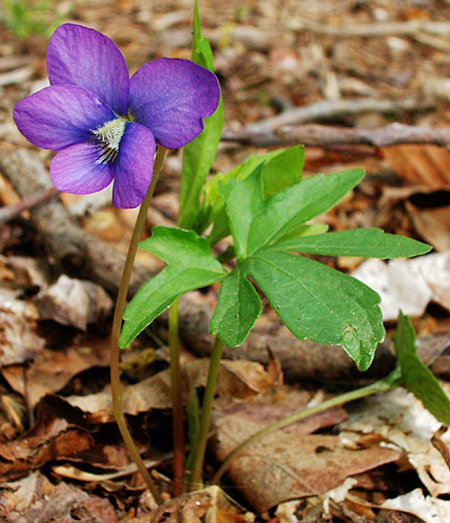
Chasmogamous flowering habit (plant at DE, White Clay Creek State Park) by David Smith, "Delaware Wildflowers" website

Chasmogamous flowering habit (plant at DE, First State National Monument adjoining Brandywine Creek State Park, 2015) by Harvey Ballard
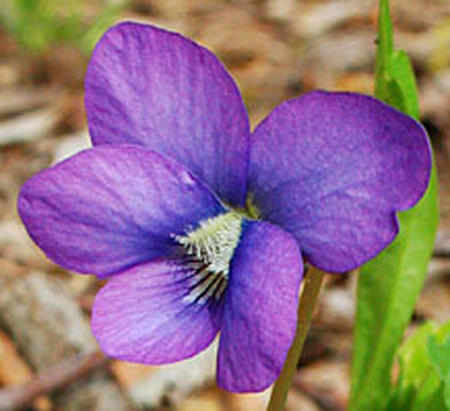
Chasmogamous flower front view (plant at DE, White Clay Creek State Park) by David Smith, "Delaware Wildflowers" website
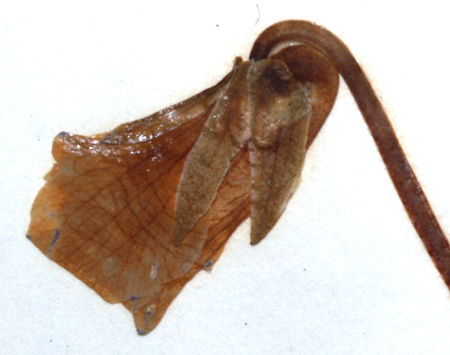
Chasmogamous flower profile view from herbarium specimen: DC, In viciniius Washington, 12 May 1873, J. W. Chickering Jr. (NY)

Cleistogamous fruit from herbarium specimen: NJ, Iselin, 28 Jul 1916, W. D. Miller 1506 (NY)
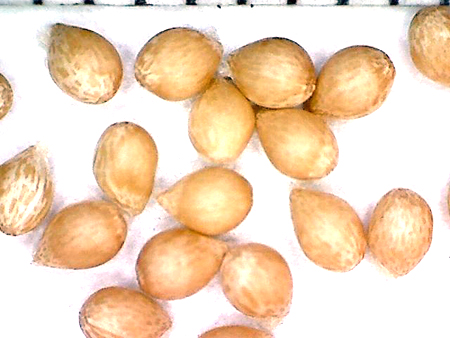
Seeds from herbarium specimen: Transplanted from DE, First State National Monument adjoining Brandywine Creek State Park, 2015, H. Ballard 15-027Y, C. Benson, J. and J. Holt (BHO)
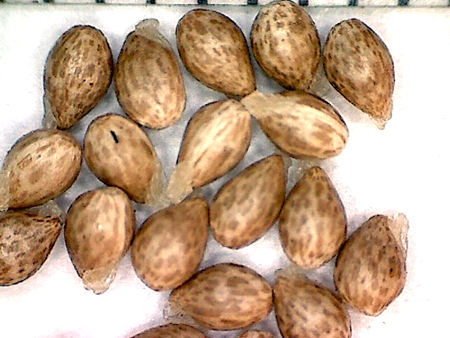
Seeds from herbarium specimen: Transplanted from PA, Delaware Co., Kelly Drive (property adjacent to Jack and Janet Holts'), 2015, H. Ballard 15-024R, C. Benson, J. and J. Holt (BHO)

Map of regionally endemic taxa in the Palmata species group by Harvey Ballard